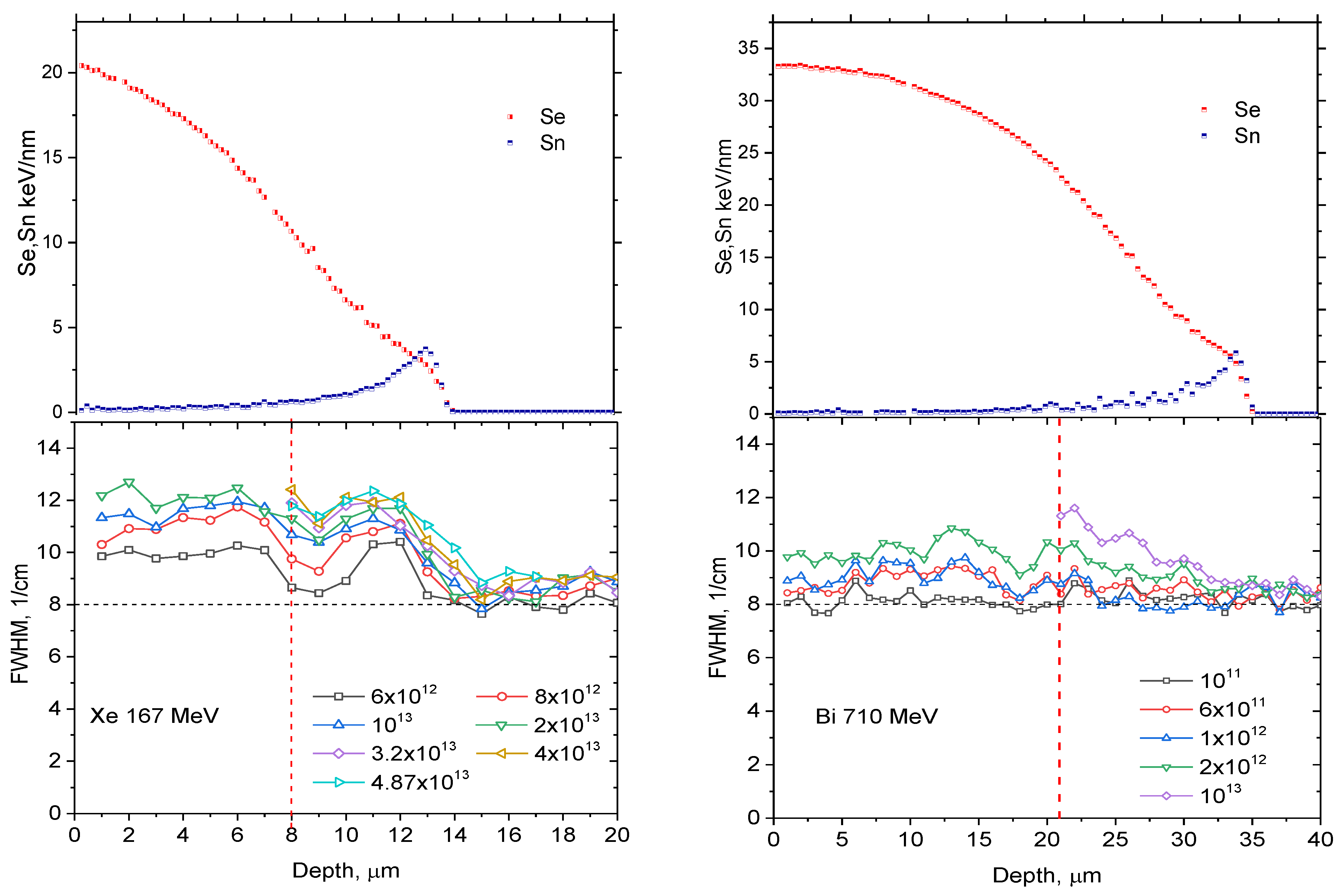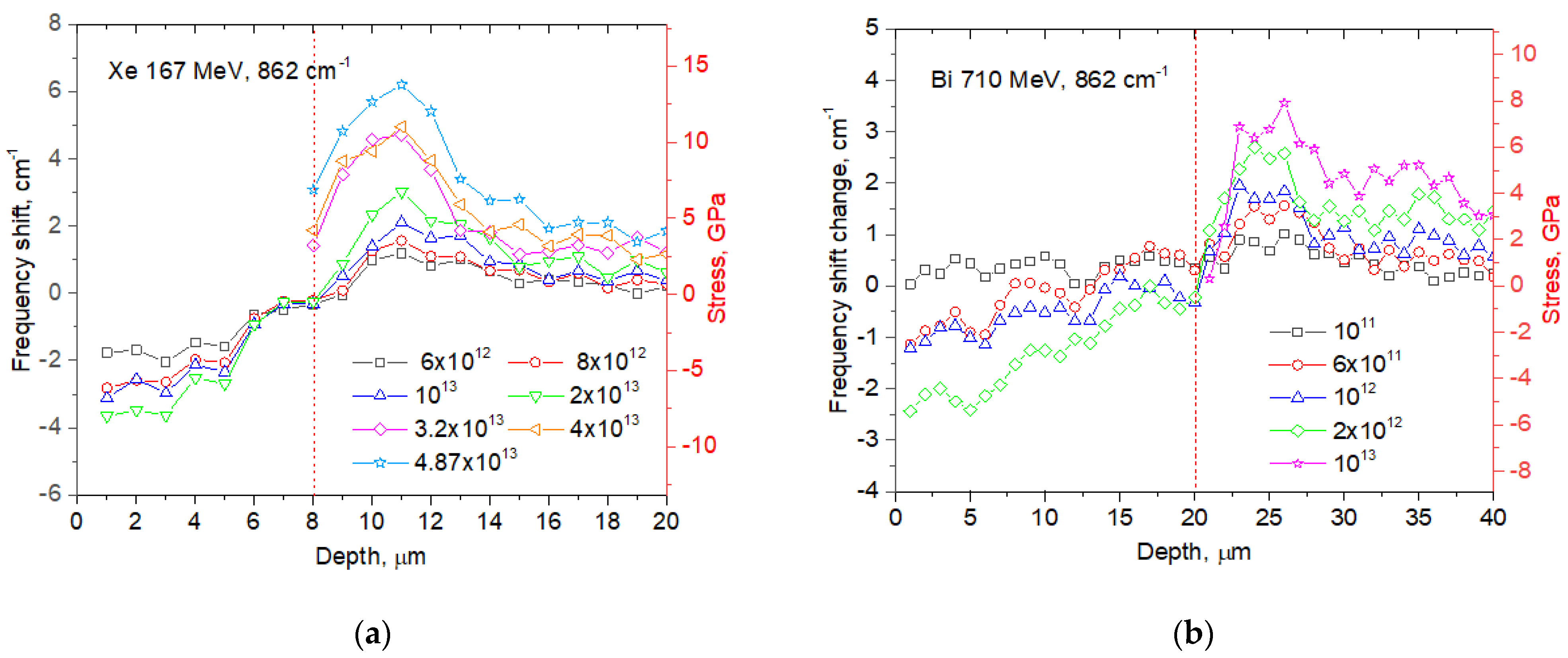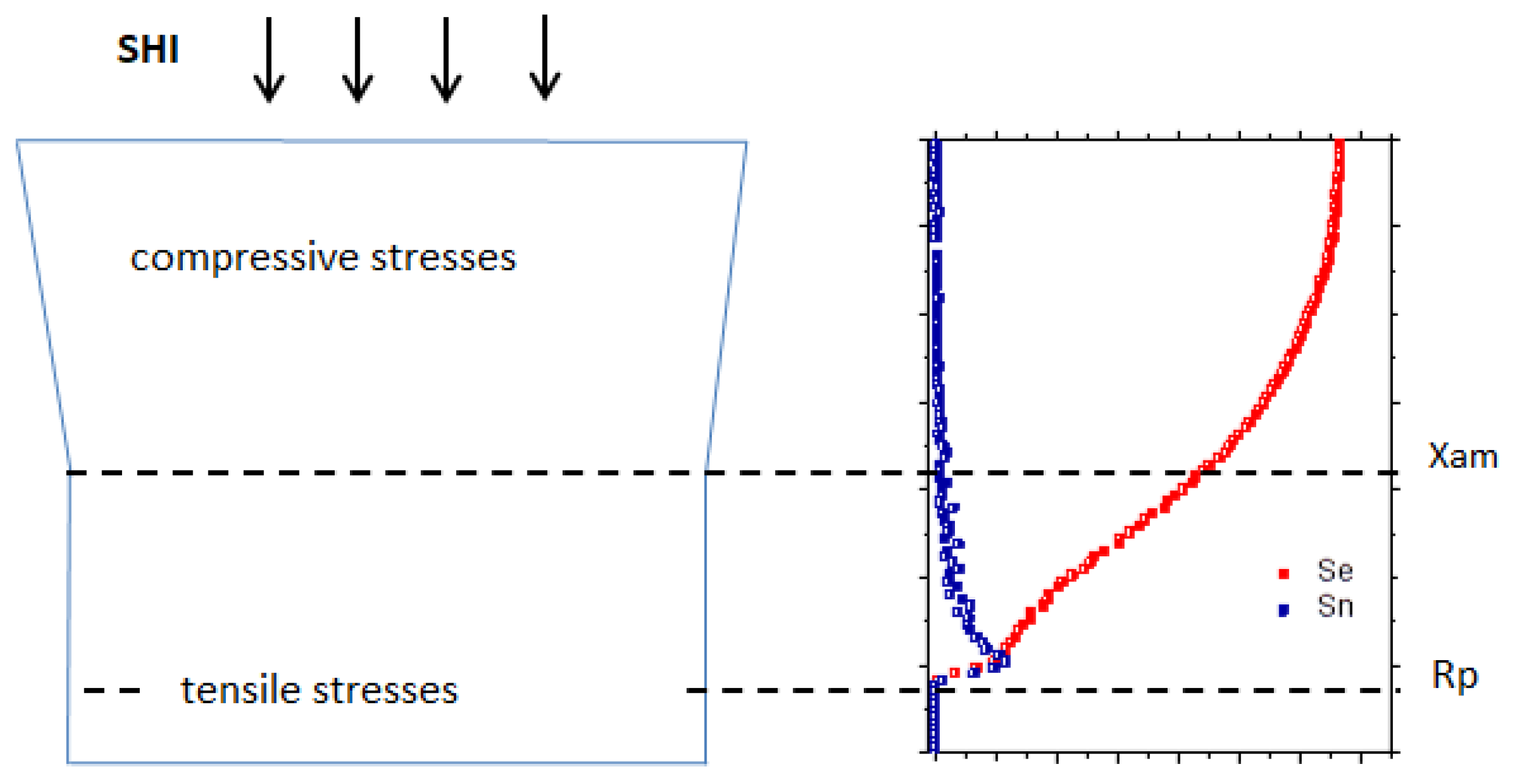Raman Study of Polycrystalline Si3N4 Irradiated with Swift Heavy Ions
Abstract
:1. Introduction
2. Experimental Details
Materials and Methods
3. Results and Discussion
3.1. Amorphization
3.2. Mechanical Stress
4. Conclusions
Author Contributions
Funding
Acknowledgments
Conflicts of Interest
References
- Murari, N.; Sergo, V.; Pezzotti, G.; Katagiri, G.; Meriani, S.; Nishida, T. Raman Piezo-Spectroscopic Behavior of Aluminum Nitride. Appl. Spectrosc. 1997, 51, 1761–1765. [Google Scholar] [CrossRef]
- Pezzotti, G. Measurements of microscopic stresses in si-based polycrystalline ceramics. Key Eng. Mater. 2005, 287, 438–448. [Google Scholar] [CrossRef]
- Ma, Q.; Clarke, D.R. Stress Measurement in Single-Crystal and Polycrystalline Ceramics Using Their Optical Fluorescence. J. Am. Ceram. Soc. 1993, 76, 1433–1440. [Google Scholar] [CrossRef]
- Molis, S.E.; Clarke, D.R. Measurement of Stresses Using Fluorescence in an Optical Microprobe: Stresses around Indentations in a Chromium-Doped Sapphire. J. Am. Ceram. Soc. 1990, 73, 3189–3194. [Google Scholar] [CrossRef]
- Forman, R.A.; Piermarini, G.J.; Barnett, J.D.; Block, S. Pressure Measurement Made by the Utilization of Ruby Sharp-Line Luminescence. Science 1972, 176, 284–285. [Google Scholar] [CrossRef]
- Sergo, V.; Clarke, D.R.; Pompe, W. Deformation Bands in Ceria-Stabilized Tetragonal Zirconia/Alumina: I, Measurement of Internal Stresses. J. Am. Ceram. Soc. 1995, 78, 633–640. [Google Scholar] [CrossRef]
- Skuratov, V.A.; Bujnarowski, G.; Kovalev, Y.S.; Havanscak, K. Piezospectroscopic study of mechanical stress in Al2O3:Cr under swift heavy ion irradiation. Vacuum 2009, 83, 65–68. [Google Scholar] [CrossRef]
- Bujnarowski, G.; Skuratov, V.A.; Havancsak, K.; Kovalev, Y.S. Accumulation of mechanical stress in Al2O3: Cr under swift heavy ion irradiation. Radiat. Eff. Defects Solids 2009, 164, 409–416. [Google Scholar] [CrossRef]
- Skuratov, V.A.; Bujnarowski, G.; Kovalev, Y.S.; O’Connell, J.; Havanscak, K. In situ and postradiation analysis of mechanical stress in Al2O3:Cr induced by swift heavy-ion irradiation. Nucl. Instrum. Methods Phys. Res. B 2010, 268, 3023–3026. [Google Scholar] [CrossRef]
- Skuratov, V.A.; Kirilkin, N.S.; Kovalev, Y.S.; Strukova, T.S.; Havanscak, K. Depth-resolved photo- and ionoluminescence of LiF and Al2O3. Nucl. Instrum. Methods Phys. Res. B 2012, 286, 61–66. [Google Scholar] [CrossRef]
- Sergo, V.; Pezzotti, G.; Katagiri, G.; Muraki, N.; Nishida, T. Stress Dependence of the Raman Spectrum of β-Silicon Nitride. J. Am. Ceram. Soc. 1996, 79, 781–784. [Google Scholar] [CrossRef]
- Zinkle, S.J.; Skuratov, V.A.; Hoelzer, D.T. On the conflicting roles of ionizing radiation in ceramics. Nucl. Instrum. Methods Phys. Res. Sect. B Beam Interact. Mater. At. 2002, 191, 758–766. [Google Scholar] [CrossRef]
- Janse van Vuuren, A.; Ibrayeva, A.; Skuratov, V.; Zdorovets, M. Analysis of the microstructural evolution of silicon nitride irradiated with swift Xe ions. Ceram. Int. 2020, 46, 7155–7160. [Google Scholar] [CrossRef]
- Janse van Vuuren, A.; Skuratov, V.; Ibrayeva, A.; Zdorovets, M. Microstructural Effects of Al Doping on Si3N4 Irradiated with Swift Heavy Ions. Acta Phys. Pol. A 2019, 136, 241–244. [Google Scholar] [CrossRef]
- Kitayama, T.; Morita, Y.; Nakajima, K.; Narumi, K.; Saitoh, Y.; Matsuda, M.; Sataka, M.; Tsujimoto, M.; Isoda, S.; Toulemonde, M.; et al. Formation of ion tracks in amorphous silicon nitride films with MeV C60 ions. Nucl. Instrum. Methods Phys. Res. Sect. B Beam Interact. Mater. At. 2015, 356, 22–27. [Google Scholar] [CrossRef]
- Janse Van Vuuren, A.; Ibrayeva, A.; Rymzhanov, R.A.; Zhalmagambetova, A.; O’Connell, J.H.; Skuratov, V.A.; Uglov, V.V.; Zlotski, S.V.; Volkov, A.E.; Zdorovets, M. Latent tracks of swift Bi ions in Si3N4. Mater. Res. Express 2020, 7, 025512. [Google Scholar] [CrossRef]
- Janse van Vuuren, A.; Ibrayeva, A.D.; O’Connell, J.H.; Skuratov, V.A.; Mutali, A.; Zdorovets, M.V. Latent ion tracks in amorphous and radiation amorphized silicon nitride. Nucl. Instrum. Methods Phys. Res. Sect. B 2020, 473, 16–23. [Google Scholar] [CrossRef]
- Canut, B.; Ayari, A.; Kaja, K.; Deman, A.L.; Lemiti, M.; Fave, A.; Souifi, A.; Ramos, S. Ion-induced tracks in amorphous Si3N4 films. Nucl. Instrum. Methods Phys. Res. Sect. B Beam Interact. Mater. At. 2008, 266, 2819–2823. [Google Scholar] [CrossRef]
- Morita, Y.; Nakajima, K.; Suzuki, M.; Narumi, K.; Saitoh, Y.; Ishikawa, N.; Hojou, K.; Tsujimoto, M.; Isoda, S.; Kimura, K. Surface effect on ion track formation in amorphous Si3N4 films. Nucl. Instrum. Methods Phys. Res. Sect. B Beam Interact. Mater. At. 2013, 315, 142–145. [Google Scholar] [CrossRef]
- Ibrayeva, A.; Janse van Vuuren, A.; Skuratov, V.A.; Zdorovets, M.V.; O’Connell, J.H. Applicability of the i-TS Model to Evaluation of Latent Track Parameters in Silicon Nitride. In Proceedings of the 20th International Conference «Radiation Effects in Insulators», Nur-Sultan (Astana), Kazakhstan, 19–23 August 2019; p. 157. [Google Scholar]
- Janse van Vuuren, A.; Ibrayeva, A.; Skuratov, V.A.; Zdorovets, M.V. iTS Model-Based Analysis of Track Formation in Crystalline and Amorphous Silicon Nitride. In Proceedings of the 13th International Conference of the Interaction of Radiation with Solids, Minsk, Belarus, 30 September–3 October 2019; pp. 97–99. [Google Scholar]
- Ziegler, J.F.; Ziegler, M.D.; Biersack, J.P. SRIM—The stopping and range of ions in matter. Nucl. Instrum. Methods Phys. Res. Sect. B Beam Interact. Mater. At. 2010, 268, 1818–1823. [Google Scholar] [CrossRef] [Green Version]
- Vogelgesang, R.; Grimsditch, M.; Wallace, J.S. Polarized ultraviolet Raman spectroscopy of β-Si3N4. J. Appl. Phys. 2002, 92, 3103–3106. [Google Scholar] [CrossRef]
- Dong, J.; Sankey, O.F. Assignment of the Raman active vibration modes of β-Si3N4 using micro-Raman scattering. J. Appl. Phys. 2000, 87, 958–959. [Google Scholar] [CrossRef]
- Wada, N.; Solin, S.A.; Wong, J.; Prochazk, S. Raman and IR absorption spectroscopic studies on α, β, and amorphous Si3N4. J. Non-Cryst. Solids 1981, 43, 7–15. [Google Scholar] [CrossRef]
- Honda, K.; Yokoyama, S.; Tanaka, S. Assignment of the Raman active vibration modes of β-Si3N4 using micro-Raman scattering. J. Appl. Phys. 1999, 85, 7380. [Google Scholar] [CrossRef]
- Takase, E.; Tani, E. Low-frequency Raman spectra of sintered Si3N4 under gas pressure. J. Mater. Sci. Lett. 1987, 6, 607. [Google Scholar] [CrossRef]
- Cai, Y.; Zeng, Q.; Zhang, L.; Cheng, L.; Xu, Y. First-principles study of vibrational and dielectric properties of β-Si3N4. J. Phys. Rev. B 2006, 74, 174301. [Google Scholar] [CrossRef] [Green Version]
- Park, S.; Lang, M.; Tracy, C.L.; Zhang, J.; Zhang, F.; Trautmann, C.; Patrick, K.; Rodriguez, M.D.; Ewing, R.C. Swift heavy ion irradiation-induced amorphization of La2Ti2O7. Nucl. Instrum. Methods Phys. Res. Sect. B Beam Interact. Mater. At. 2014, 326, 145–149. [Google Scholar] [CrossRef]
- Tracy, C.L.; Pray, J.M.; Lang, M.; Popov, D.L.; Park, C.; Trautmann, C.; Ewing, R.C. Defect accumulation in ThO2 irradiated with swift heavy ions. Nucl. Instrum. Methods Phys. Res. Sect. B Beam Interact. Mater. At. 2014, 326, 169–173. [Google Scholar] [CrossRef]
- Park, S.; Tracy, C.L.; Zhang, F.; Park, C.; Trautmann, C.; Tkachev, S.N.; Lang, M.; Mao, M.L.; Ewing, R.C. Radiation-induced disorder in compressed lanthanide zirconates. Phys. Chem. Chem. Phys. 2018, 20, 6187–6197. [Google Scholar] [CrossRef]
- Okubo, N.; Ishikawa, N.; Sataka, M.; Jitsukawa, S. Surface amorphization in Al2O3 induced by swift heavy ion irradiation. Nucl. Instrum. Methods Phys. Res. B 2013, 314, 208–210. [Google Scholar] [CrossRef]
- Weber, W. Models and mechanisms of irradiation-induced amorphization in ceramics. Nucl. Instrum. Methods Phys. Res. Sect. B Beam Interact. Mater. At. 2000, 166–167, 98–106. [Google Scholar] [CrossRef]
- Muraki, N.; Katagiri, G.; Sergo, V.; Pezzotti, G.; Nishida, T. Mapping of residual stresses around an indentation in β-Si3N4 using Raman spectroscopy. J. Mater. Sci. 1997, 32, 5419–5423. [Google Scholar] [CrossRef]
- Sattonnay, G.; Moll, S.; Herbst-Ghysel, M.; Legros, C.; Costantini, J.M.; Thomé, L. Mechanical stresses induced in ceramic oxides by ion irradiation. Nucl. Instrum. Methods Phys. Res. Sect. B 2008, 266, 3052–3056. [Google Scholar] [CrossRef]
- Sattonnay, G.; Lahrichi, M.; Herbst-Ghysel, M.; Garrido, F.; Thomé, L. Stress field induced by swift heavy ion irradiation in cubic yttria stabilized zirconia. J. Appl. Phys. 2007, 101, 103516. [Google Scholar] [CrossRef]
- Sattonnay, G.; Lahrichi, M.; Benyagoub, A.; Costantini, J.M.; Garrido, F.; Thome, L.; Trautmann, C. Structural modifications induced by swift heavy ions in cubic stabilized zirconia: An X-ray diffraction investigation. Nucl. Instrum. Methods Phys. Res. B 2007, 257, 476–479. [Google Scholar] [CrossRef]





| Ion | Energy, MeV | Se, keV/nm | Rp, μm | Fluence, cm−2 |
|---|---|---|---|---|
| 132Xe | 167 | 20.8 | 13.4 | 6 × 1012, 8 × 1012, 1 × 1013, 2 × 1013, 3.2 × 1013, 4 × 1013, 4.87 × 1013 |
| 209Bi | 710 | 33.6 | 29.8 | 1 × 1011, 6 × 1011, 1 × 1012, 2 × 1012, 1 × 1013 |
| Theory | Experiment | |||||||||
|---|---|---|---|---|---|---|---|---|---|---|
| [24] | [25] | [28] | [11] | [26] | [23] | This work | ||||
| 144 | (145) | Ag | Ag | |||||||
| 183 | E2g | 186 | 181 | 183 | 185 | E2g | 182 | E2g | 183.33 | E2g |
| 201 | Ag | 210 | 200 | 206 | 208 | Ag | 204 | Ag | 203.61 | Ag |
| 228 | E1g | 229 | 225 | 227 | 230 | E1g | 225 | E1g | 226.71 | E1g |
| 444 | E2g | 451 | 444 | 449 | 452 | E2g | 447 | E2g | 449.38 | E2g |
| 457 | Ag | 456 | Ag | 457 | Ag/E2g(?) | |||||
| 603 | E2g | 619 | 610 | 617 | 620 | E2g | 613 | E2g | 614.24 | E2g |
| 715 | Ag | 732 | 725 | 730 | 733 | Ag | 727 | Ag | 729.82 | Ag |
| 836 | E1g | 865 | 859 | 863 | 866 | E1g | 856 | E1g | 862.70 | E1g |
| 897 | E2g | 928 | 921 | 927 | 730 | E2g | 921 | E2g | 927.22 | E2g |
| 908 | Ag | 939 | 930 | 937 | 940 | Ag | 932 | Ag | 938.78 | Ag |
| 1012 | E2g | 1047 | 1021 | 1045 | 1048 | E2g | 1039 | E2g | 1045.47 | E2g |
Publisher’s Note: MDPI stays neutral with regard to jurisdictional claims in published maps and institutional affiliations. |
© 2021 by the authors. Licensee MDPI, Basel, Switzerland. This article is an open access article distributed under the terms and conditions of the Creative Commons Attribution (CC BY) license (https://creativecommons.org/licenses/by/4.0/).
Share and Cite
Zhumazhanova, A.; Mutali, A.; Ibrayeva, A.; Skuratov, V.; Dauletbekova, A.; Korneeva, E.; Akilbekov, A.; Zdorovets, M. Raman Study of Polycrystalline Si3N4 Irradiated with Swift Heavy Ions. Crystals 2021, 11, 1313. https://doi.org/10.3390/cryst11111313
Zhumazhanova A, Mutali A, Ibrayeva A, Skuratov V, Dauletbekova A, Korneeva E, Akilbekov A, Zdorovets M. Raman Study of Polycrystalline Si3N4 Irradiated with Swift Heavy Ions. Crystals. 2021; 11(11):1313. https://doi.org/10.3390/cryst11111313
Chicago/Turabian StyleZhumazhanova, Ainash, Alisher Mutali, Anel Ibrayeva, Vladimir Skuratov, Alma Dauletbekova, Ekaterina Korneeva, Abdirash Akilbekov, and Maxim Zdorovets. 2021. "Raman Study of Polycrystalline Si3N4 Irradiated with Swift Heavy Ions" Crystals 11, no. 11: 1313. https://doi.org/10.3390/cryst11111313








